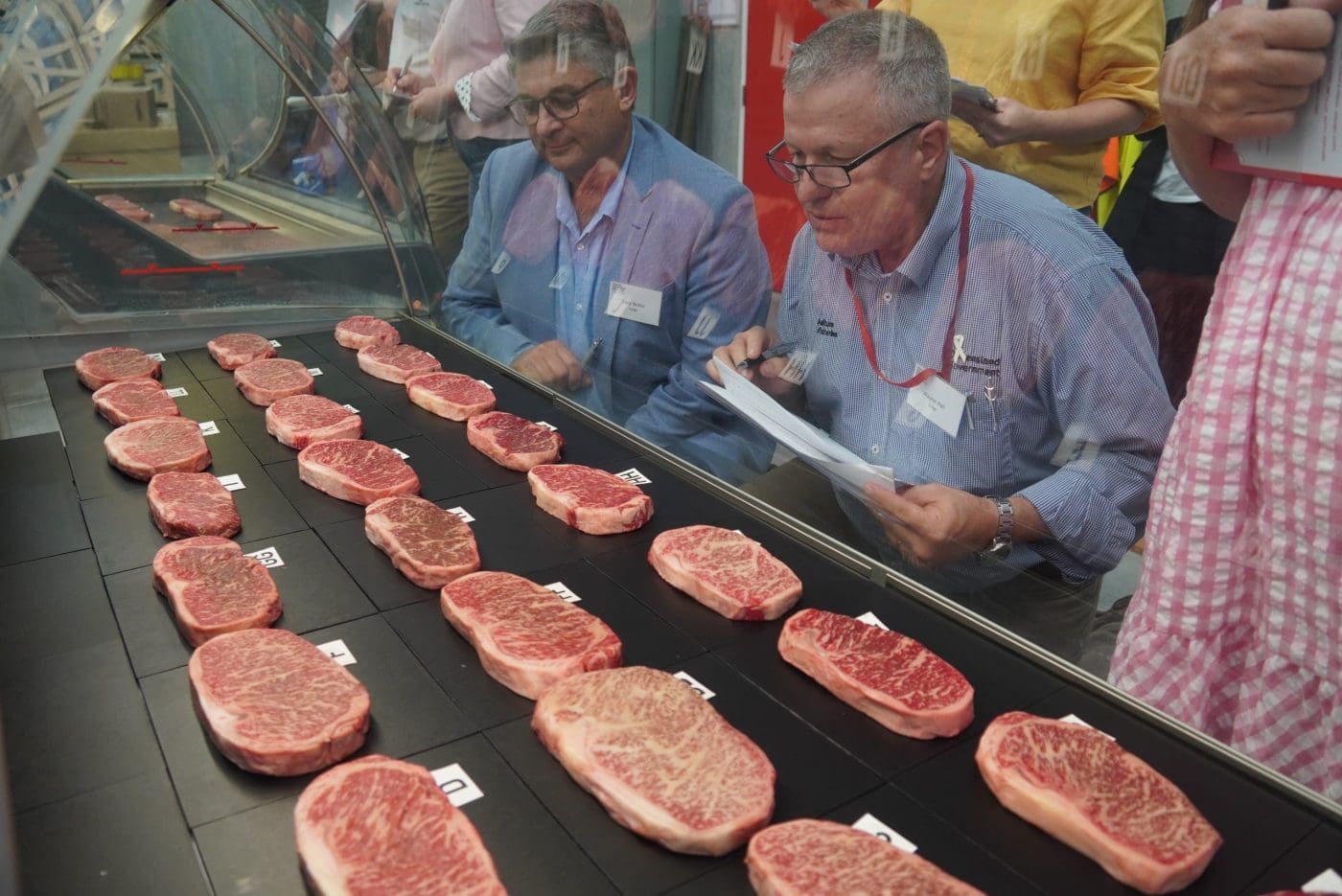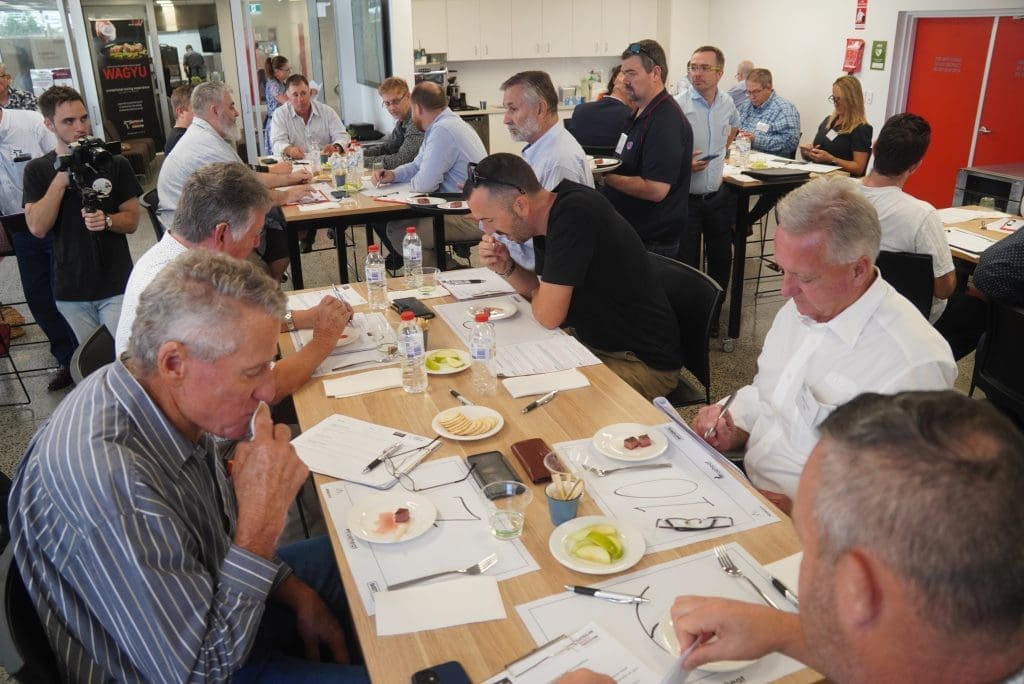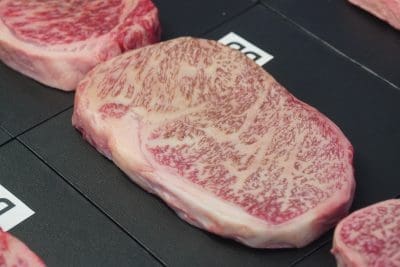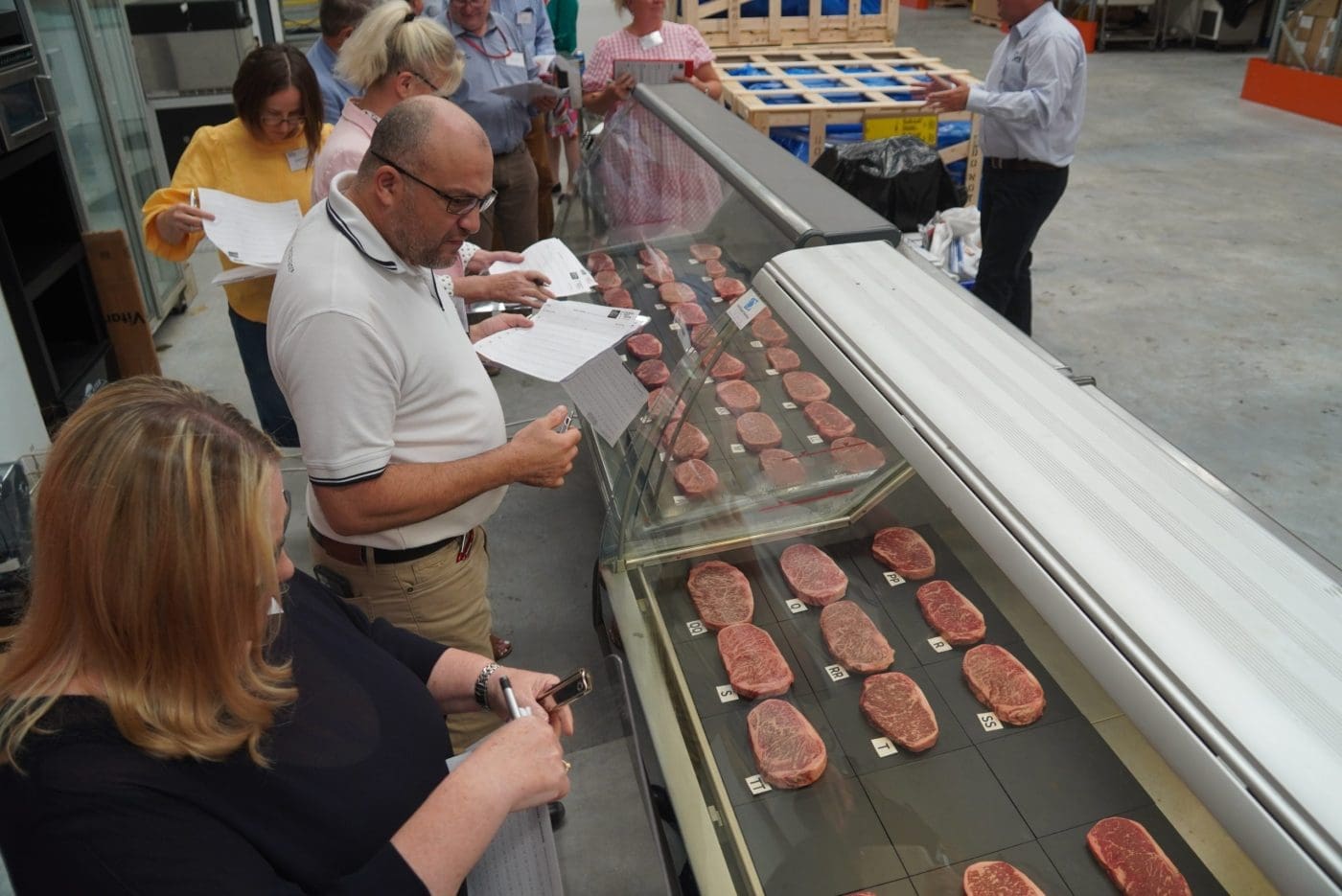
AWA branded beef judges scrutinise competition entries in the raw uncooked state as part of Tuesday’s competition. Click on image for a larger view
AS the shadow of COVID starts to clear and restaurant and hotel diners around the world emerge from two years of slumber, their expectations over quality have never been higher.
Patrons ordering a serve of expensive Wagyu in a nice steak restaurant in Singapore, San Francisco, Saigon or Sydney expect an outstanding experience, and after building a big stash of disposable income in the absence of travel and dining out during COVID, are clearly prepared to pay for it.
It’s meant that premiums being paid for higher marbling Australian Wagyu beef (scores 8-9 and higher) have expanded, relative to mid marbling scores 5-7.
And Australian Wagyu supply chains have reacted to this by investing in nutritional and management support to ensure that as many carcases as possible grade at the upper end of the scale.
This trend was in clear evidence during judging held on Tuesday for the 2022 Australian Wagyu Association’s annual Branded Wagyu Beef Competition held in Brisbane, in which Beef Central’s Jon Condon took part.
Competition coordinator Ron Fitzgerald said a record 46 entries had been received this year from supply chains across Australia, up almost 50pc on last year. There were 12 Fullblood Wagyu entries, 17 in the crossbred class, and 17 in the commercial Wagyu (mid marbling score range) class.
The sharp growth in Fullblood entries reflects the growing emphasis on Fullblood Wagyu production being seen across the Australian industry, as a proportion of overall Wagyu cattle being bred and fed.
Another of this year’s branded beef judges was veterinarian and feedlot nutrition consultant Dr Matt George, from Bovine Dynamics.

Dr George said part of the explanation behind the trend in higher marbling performance this year was the ‘drive for quality,’ with bigger premiums being paid for carcases with higher marbling scores versus more moderate scores.
“That’s being reflected in days on feed,” he said.
“There is a distinct trend towards extending time on feed, to try to extract optimum marbling scores on every beast. I think it is potentially pushing another 8-10pc of Wagyu carcases into the high marbling score 8-9 range.
“That’s certainly the feedback we are getting from our feedlot clients. The other point is that the industry continues to get better at what they do.”
“Instead of producing too many score 7-9 carcases, which used to be almost a problem in some market channels, that’s no longer the case. Consumers want that really highly-marbled product, and are prepared to pay for it. It’s becoming more mainstream globally.”
Dr George thought days on feed had typically expanded by somewhere between 25 and 50 days, depending on the program. Some of the shorter-fed Wagyu programs that had earlier retracted to 300 or 350 days, had now advanced to 400+ days.
“It’s perhaps less for the Fullblood programs 550-600 days, but the median value for days on feed has definitely changed,” he said.
“It’s the markets’ (both export and domestic) willingness and capacity to pay for premium beef that has driven this. COVID has driven this pent-up consumer demand. The question now is whether that remains, or whether high fuel prices, interest rates and other factors re-introduce stag-flation, and slow this trend.”

Tuesday’s judging in progress
Drought’s shadow
Given the exceptionally long lead-time on longfed Wagyu cattle from conception to slaughter, Beef Central asked Dr George whether there was still a lingering drought impact on this year’s competition entries, in terms of compromised marbling performance or growth rate.
“I think the drought effect has now largely gone – thankfully,” he said.
“The drought broke earlier in southern Wagyu-producing areas than it did further north,” Dr George said.
“It (compromised performance) could still be applying to a small percentage of the Wagyu feeder cattle coming out of northern Australia, but I think we are now largely out of that phase.”
Dr George said Wagyu feeders were in general now considerably heavier at the same age than they were two years ago – especially out of concentrated production regions like the New England.
“The one paradigm in that is that some Wagyu calf producers are still trying to exit their cattle early – purely because of the extraordinary prices available for light backgrounder-type cattle.”
“Some people are happy to tip them out early, because the value is so high for those lighter Wagyu backgrounders.”
Marbling key feature of 2022 entries
Advances in the abundance of marbling in entries was a key feature of note in Tuesday’s AWA judging, clearly evident at the raw, uncooked stage of assessment.
Driven by the factors described above, there was clear evidence that Wagyu supply chains continue to push the boundaries of marbling performance.

Click on image for a larger view
It was only four or five years ago that the first competition entry carrying intra-muscular fat (IMF, proxy for marbling) levels above 50 percent was seen.
This year, there were 4-5 that potentially broke through 50pc IMF, including one extreme outlier (pictured) that experts in the room suggested pushed the 60pc IMF boundary. That’s an unprecedented result in Australian Wagyu branded beef competition.
While AusMeat’s marbling score range finishes at 9, and Japanese Meat Grading Association marbling scores (BMS) finish at 12, the use of the Meat Image Japan (MIJ) grading camera in Tuesday’s competition allowed the generation of ‘theoretical’ scores beyond the accepted range. In the case of the competition entry pictured, organisers suggested it was close to a BMS 15, with an eye muscle areas of at least 150sq cm.
While it appeared that the Fullblood entries dominated the competition’s more extreme marbling performers, there were also crossbred entries this year that pushed new boundaries for marbling performance.
Chief competition steward Dr Alex Ball said some of the product represented in Tuesday’s competition was “right at the top end of world’s best” in the spectrum of global Wagyu supply.
“In cutting and preparation before the judging began, we saw some truly sensational Wagyu product,” he said. “This is really setting the trend for where Australian beef can actually go, and this particular competition is setting the pinnacle for where Australian beef can position itself, and more importantly, where we can position ourselves globally.
“All of the objective measurement technology is providing the statistical data, but unless each sample can actually satisfy the consumer (represented in this case by the 30-odd competition judges) we don’t know how good the product actually is.”
“We expect the ultimate champion chosen from this year’s competition will be right at the top end of world’s best for Wagyu beef,” Dr Ball said.
Australian premium Wagyu Vs Japan
So how does contemporary Australian high-end Wagyu now measure up against the best Japanese domestic Wagyu beef?
Comparisons are difficult, for a number of reasons. Firstly, Japanese Wagyu cattle are micro-managed, at an individual animal level, with frequent blood sampling for vitamin A levels and nutritional adjustment. In contrast, Australian Wagyu are fed and managed on a mob basis – often 100-200 head per pen – for practical commercial reasons.
Secondly, high-end A5 grade Wagyu are often fed in Japan out to 800 or 900 days, when 500-600 days is the absolute ceiling for Australian Fullblood programs. This means cost of production of a Wagyu beast in Japan is typically three times as high as that in Australia, although intra-muscular fat levels of up to 60pc have been recorded in high-end Japanese domestic Wagyu fed for two and a half years.
Competition winners
So who were the winners from Tuesday’s 2022 AWA branded Wagyu beef competition judging?
All will be revealed at the competition awards ceremony, held as a centrepiece of the AWA’s 2022 Wagyu conference in Melbourne from 26 April to 1 May. Click here for details.

